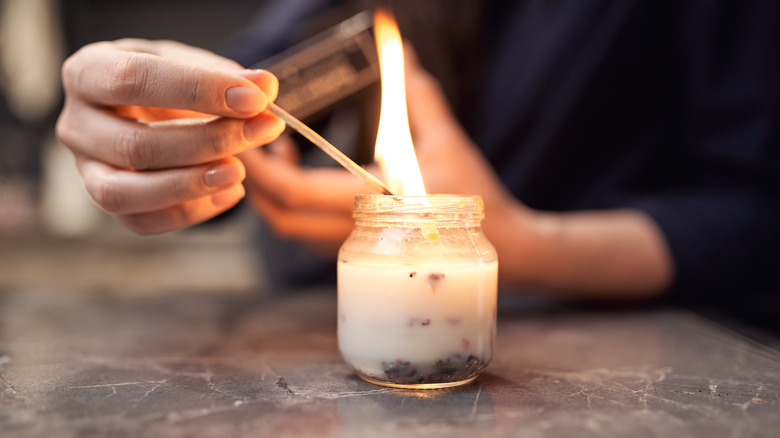Are TikTok's Health Concerns About Scented Candles Something Worth Worrying Over?
Nothing can set the tone of a room quite like a scented candle. A pumpkin spice candle inspires the beauty of autumn, a pine-scented candle makes you think of the winter holidays, and a fresh floral or clean fragrance energizes you in the spring. Lighting a candle can have some unexpected health benefits, but some TikTok users might have you freaking out about them.
One TikTok user said she fell asleep with a candle burning and then stuck her finger up her nose. Her finger revealed black soot, and she also showed her black nostrils. The TikTok doctor who responded said candles will produce soot when they're burned for too long. This soot could cause damage to your lungs.
Dr. Mike Varshavski, a board-certified family medicine doctor, posted on YouTube that although scented candles can emit toxic chemicals, they aren't as harmful as TikTok users warn us about. What might put you at ease is understanding what happens when you burn a candle and how you can limit the amount of toxins it emits.
Scented candles give off pollutants
You'll find three types of pollutants in the air. The first is volatile organic compounds (VOCs), and the most well-known carcinogenic (cancer-causing) VOCs are benzene and formaldehyde. Your typical scented air freshener can have more than 100 VOCs, according to The Conversation. When VOCs meet other oxidants in the air, your indoor air can become toxic. Phthalates are like VOCs, and these are unique to scented candles and anything with a scented fragrance.
You also need to be concerned about particulate matter like soot because these fine particles can enter your bloodstream through your lungs. You might notice soot around your fireplace or the inside of the jar of your candle. Soot is produced when the flame of your candle doesn't have enough oxygen. You might notice more soot when you first light your candle or when you put it out. Inhaling soot can increase your risk of lung cancer, asthma, and COPD.
How much pollutants do scented candles give off?
Different fragrances in scented candles give off different amounts of chemicals, according to a 2015 article in the Journal of Hazardous Materials. Researchers studied chemicals released from five scented candles and an unscented candle to determine the types and amounts of chemicals. The strawberry-scented candle gave off the largest amount of formaldehyde, and some scented candles emitted excessive VOCs even before they were lit.
Don't freak out, though. A 2021 study in Environment International studied various scented candles and four types of candle waxes in controlled environments. They burned the candles for seven hours, measuring the levels of VOCs such as benzene, naphthalene, and formaldehyde. Even during the extended burning time, the levels of pollutants were well below the safety measures set by organizations such as the World Health Organization and the Environmental Protection Agency (EPA). The types of wax in the candles didn't vary in terms of levels of pollutants. Because the fragrances are mostly responsible for the VOCs in the air, candles with no fragrance give off the least amount of pollutants.
Only two substances, benzo(a)pyrene (which shows incomplete burning) and acrolein, sometimes exceeded long-term safety limits. Benzo(a)pyrene is a carcinogen often found in grilled meats, cigarette smoke, asphalt roads, and vehicle exhaust. Meanwhile, acrolein doesn't only come from burning candles, but also from burning tobacco, wood, or plastics. Acrolein can irritate your eyes, nose, and throat.
What are the effects of burning scented candles?
You'll find up to 3,000 varieties of fragrances in household products such as scented candles, but not all fragrances give off the same levels of VOCs. A 2017 review in Environment International looked at the effects of common scents such as lavender, citrus, pine, and cinnamon. Although you might notice these smells in your home, the substances these fragrances emit aren't high enough to irritate your eyes or airways. You're also less likely to experience any lung issues from breathing in these fragrances. Some people are allergic to scented candles and other products with fragrances.
Because some pollutants found in scented candles could cause cancer, you might think you need to put away your favorite scents for good. According to a 2019 article in Cancer Prevention Research, chemicals in scented candles like benzopyrene can cause genetic mutations that can increase your risk of bladder cancer. Formaldehyde and phthalates are also linked to bladder cancer. While scented candles alone might not release enough toxic chemicals to give you cancer, the combination of scented candles with other household pollutants could potentially put you at risk.
What other pollutants can be toxic with scented candles?
Even though scented candles get a bad rap on TikTok, you'd be surprised how many other sources of indoor air pollution could be in your home. According to The Conversation, your indoor air can become toxic if these VOCs meet other oxidants in the air. If you use a wood-burning stove or fireplace, you're releasing the same pollutants into the air as a scented candle, per the EPA. Smoke from tobacco products also emits harmful chemicals that can get into your lungs, clothes, and furniture.
Remodeling your home can also expose you to some of these same harmful pollutants, especially if you install new flooring or certain types of wood for your cabinets. Too much moisture in your home can also become a source of indoor air pollution. Remember that your household products also release chemicals into your home. The Conversation says that many products labeled "green" or "organic" can be misleading because essential oils can still form pollutants once they reach the air.
How to burn your scented candles safely
The National Candle Association suggests trimming the wick of your candle ¼ inch before burning to avoid uneven burning and clearing the candle of any excess debris. Candles should also be burned in a room that has good ventilation but is away from fans or windows. That will reduce the candle's oxygen supply and increase the amount of soot it produces.
Although candle manufacturers might differ in their instructions, candles shouldn't be burned for more than four hours at a time. Unlike the one user on TikTok, avoid falling asleep with your candle burning or leaving it unattended. You also don't want to burn a candle all the way down. Instead, extinguish it when ½ inch of wax remains. A candle releases a lot of soot when it smolders, so it's best to use a candle snuffer to extinguish the candle.
The EPA also suggests improving the ventilation in your home to remove any pollutants from scented candles or other household products. This could mean opening your windows from time to time or allowing outside air to circulate through your heating and cooling units. Air cleaners can also remove some of the particles in your home. You also don't need to cleanse your lungs or buy detox formulas that promise to rid your body of toxins from scented candles. Dr. Varshavski says these are a waste of money.





